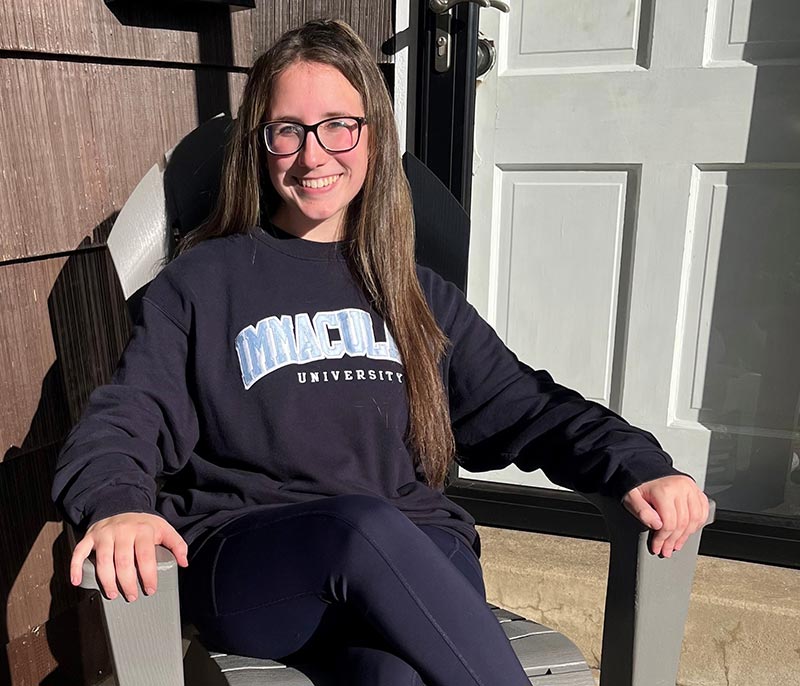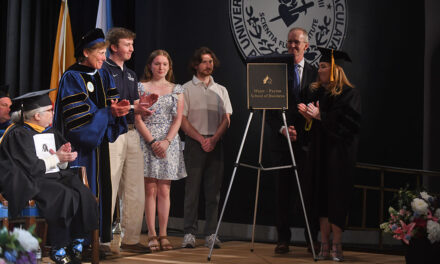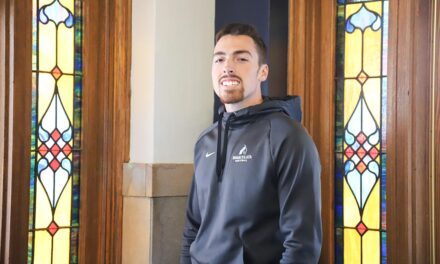When Paige Homka walked into her sports psychology class, she didn’t expect to spend the semester analyzing the Philadelphia 76ers. However, the 2025 graduate of Villa Maria Academy was part of Immaculata University’s dual enrollment program, which gives high schoolers a head start on college by earning credit before graduation.
Dual enrollment is not new at Immaculata, but it is growing fast. In spring 2025, 917 students took 3,829 college credits through the program. For $125 per credit, Immaculata’s dual enrollment program helps students earn both high school and college credits, which are generally transferable to other accredited colleges or universities. The classes also offer students something less tangible: confidence that they can handle college work.
“Dual enrollment can be beneficial, especially as a bridge from high school to college,” said Jean Shingle, dean of the College of Undergraduate Studies. “The confidence in taking and passing a college-level course is instrumental in knowing that you can succeed in college.”
Who’s Taking Part
Immaculata’s program attracts students from 29 public, private and Catholic high schools, who partner with Immaculata to offer courses. For the fall 2025 semester, over 400 students participated.
Students can take classes in multiple ways — at their high schools, on Immaculata’s campus or online. Popular classes range from psychology and statistics to public speaking, Spanish and chemistry. Faculty say the high school students rise to the challenge. Toe Aung, assistant professor in the Department of Psychology and Counseling, acknowledges that dual enrollment students show a level of maturity, take their studies seriously and are motivated to succeed.
Stephen Mason, Ph.D., associate professor of biology, teaches human ecology to students participating in dual enrollment. The 100-level science course is designed for non-science majors to explore how humans impact surrounding ecosystems. “Because it’s geared toward non-majors, the material is approachable and relatable while still offering enough depth to feel meaningful,” Mason notes. “The course also integrates engaging online homework that helps reinforce concepts, making it a strong entry point into the college classroom experience.”
Student Stories

Homka’s sports psychology class combined lectures with case studies, reflection essays and personal exploration. “Not only did I learn a lot about how our mind and body work, but I also learned how it functions with something I love, which is sports,” she said.
Her Villa Maria classmate, Amelia Dedda, enrolled in data analytics. She was introduced to both the power of data and the challenges posed by artificial intelligence. Dedda credits the class for encouraging her to think critically about how society is changing with the use of AI.
Similarly, another student from Villa Maria, Brynn Goldstein ’27, found her dual enrollment course in world religions gave her an early glimpse of college-level learning. Through note-taking, analyzing key ideas in texts and presenting in class, she built skills that prepared her for higher education. Inspired by this experience, Goldstein chose to continue her studies at Immaculata as an education major.
A National Trend
Immaculata’s growth mirrors a national boom in dual enrollment. Nationwide, participation has ballooned from about 300,000 students in the early 2000s to 2.5 million in 2022–23, according to the National Alliance of Concurrent Enrollment Partnerships (NACEP). In some states, nearly half of public high school students earn college credits before graduation. Research also suggests dual enrollment pays off, as students in these programs are more likely to receive scholarships and grants. Additionally, financial aid often increases in proportion to the number of dual enrollment courses students take.
For Aung, the benefits go beyond academics. “Students can explore academic and career interests early on,” he said. “By taking classes alongside college students and adult learners, they gain valuable perspectives and learn directly from their peers.”
Looking Ahead
With strong demand, Immaculata plans to expand its partnerships with regional high schools and reach more students who may not know about dual enrollment — especially those from underserved backgrounds.
The Gates Foundation reports that dual enrollment improves both high school and college graduation rates. Advocates also stress the importance of making programs accessible to low-income and minority students and aligning coursework with future careers.
“Dual enrollment can be the confidence-booster and momentum-builder needed to get students to enroll in education after high school—which data shows gives them the best chance of landing a good job,” wrote Bill Tucker and Sylvia Symonds in a Gates Foundation article.
For Homka, the payoff was immediate. “I am so happy I had the opportunity to take such an interesting class at the collegiate level,” she said.






